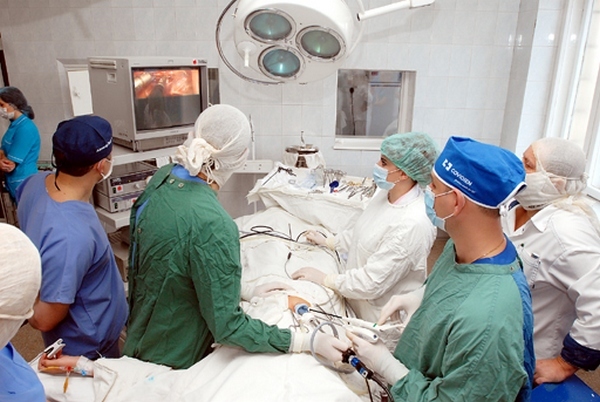Inflammation of the epididymis and cyst of the ovary became a real scourge, persecuting modern women of reproductive and advanced age. What signs and symptoms do you need to know about women, including those in an interesting position for immediate treatment of a gynecologist?
Classification and causes of
In gynecology, the term "appendages" is used for the common name of ovaries and uterine( fallopian) tubes.
Adnexitis

Inflammatory processes in the ovaries and tubes proceed in the same way and very rarely develop in isolation, so the disease received a mixed name - salpingo-oophoritis( adnexitis).
The lesion begins with the inner layer of the tubes, seizes the middle and outer shells, then flows onto the integumentary epithelium of the ovaries. In this case, pathological processes can affect both ovaries( both tubes) or localize only on one side.
Inflammatory processes in the ovaries and fallopian tubes of are caused by infectious agents, including sexually transmitted infections .These include:
- chlamydia, gonococci, myco-and ureaplasma;
- Staphylococcus aureus, Streptococcus, Escherichia coli,
- Mycobacterium tuberculosis and other pathogenic viruses and bacteria, as well as non-spore forming anaerobes.
As a rule, these infectious agents come from the lower genital tract( an upward infection), therefore fires inflammation of the vaginal mucosa( vaginitis, colpitis) and / or vulvitis vulva will inevitably lead to inflammation of the appendages.
Less commonly, inflammatory pathogens can penetrate from:
- peritoneum;
- of the rectum or appendix;
- spread through the bloodstream.
By localization of the inflammatory process with 90% probability it is possible to assume which of the infections caused adnexitis:
- bilateral inflammation is a consequence of defeat by chlamydia, gonococci or tubercle bacillus;
- unilateral( right or left) - a manifestation of "activation" of Escherichia coli, staphylococci, streptococci or enterococci.
Ovarian cyst
Of inflammatory diseases that affect only the ovaries, the cyst is the most common type of pathology. An ovarian cyst is a benign tumor in the form of a thin-walled "sac" filled with semi-liquid contents, which can appear outside or inside the body of the itself.
There are the following varieties of cysts:
- follicular( functional);
- luteal( yellow body);
- hemorrhagic;
- dermoid;
- endometriosis( "chocolate");
- of the cystadenoma;
- polycystic syndrome.
In 70% of cases the cyst arises as a functional feature of the "defective" maturation of the egg and passes to the next menstruation. In other cases, it can reach not only huge sizes, but also degenerate into a malignant tumor. With early diagnosis and treatment, a situation where surgical intervention is required, are rare.
Ovarian cyst can be a consequence of surgical interventions, inflammatory diseases or hormonal failure, including the resulting imbalance of hormones in the body of a pregnant woman.
The cause of cyst formation in the left ovary can be chronic colitis. The causes of cysts in the right ovary include not only colitis, but also an operation to remove the appendix.
"Provocators"

The most frequent and the first cause of inflammation of the appendages is the hypothermia of the body - wearing clothes and shoes not for the season, ignoring drafts, frequent soaking of feet, prolonged bathing in cold water.
Other predisposing factors that weaken the immune system and trigger the disease development mechanism include:
- regular large blood loss during menstruation;
- chronic diseases of internal organs and untreated infectious diseases;
- overwork, stress and depressive states;
- excessive diets;
- classes "male" sports or work associated with increased physical exertion.
Women should pay special attention to the treatment of mechanical damage to tissues obtained during abortion or during labor. The same warning applies to women who have undergone gynecological surgeries.
To provoking factors contributing to the occurrence of ovarian cysts, include:
- the appearance of menstruation at the age of 11 years;
- irregular menstrual cycle;
- reception of oncoprotein Tamoxifen;
- diseases caused by hormonal disorders;
- complications after gynecological operations;
- obesity;
- smoking.
For the formation of the ovarian cyst, which can degenerate into a malignant tumor, a woman's age threshold is more than 40 years old provoking the factor.
Symptoms
Symptoms of inflammation of the uterine appendages and ovarian cysts are diverse and depend on the stage and degree of spread.
General characteristics of signs of adnexitis
Common signs of ovarian inflammation are menstrual cycle failure, decreased sexual desire, pain in the lower part of the trunk, irritation, itching and discharge from the vagina.
The pains in the lower abdomen can be acute paroxysms or almost uninterrupted dull and aching. Often women complain of pain in the lumbar region or sacrum. All varieties of pain intensify after cooling, before menstruation( dysmenorrhea). Special complaints from women come on arising pains during intercourse.
Symptoms of inflammation of the ovaries that cause particular discomfort are seborrheic or serous discharge( whites).The discharged liquids can be colorless, white, gray. In purulent cases they have a dirty yellow or marsh greenish color, and are accompanied by an extremely unpleasant odor.
As a result, from exuberant discharge there is irritation of the mucous membranes of the vagina and a strong annoying itching of the external genitalia.
Symptoms of acute adnexitis

Acute inflammation of the appendages is accompanied by:
- with fever above 38 ° C, chills and febrile condition;
- with nausea, general lethargy and sharp cutting pains in the solar plexus area;
- with purulent discharge;
- appendages increase in size and when palpation respond with acute intolerable pain, and when the uterus moves, painful sensations arise.
The duration of the acute course is 1-2 weeks, after which the disease passes into a subacute and then into a chronic form and will require a woman to make significant efforts for complete cure.
Chronic adnexitis manifestations
Chronic course is dangerous due to the lack of pronounced symptoms. In most cases, the diagnosis is made only after the woman turns to the gynecologist with the problem of not being able to get pregnant for a long time.
During gynecological examination, the doctor feels palpation of the appendages, while during such manipulation, women complain of moderate pain.
As a result of chronic purulent inflammatory process, not only the appendages themselves are affected, but also the inner membrane of the abdominal cavity - there are adhesive connections of the peritoneal sheets among themselves, which are manifested by constant constipation or diarrhea.
In addition to a disorder of the stool, chronic adnexitis is always accompanied by a mild, greased pain in the area below the stomach.
Symptoms of ovarian cyst
As a rule, the functional ovarian cyst does not manifest itself in any way and is diagnosed accidentally by ultrasound examination of another disease.
Other varieties of ovarian cysts are characterized by the following symptoms:
- pallor, attacks of dizziness( until loss of consciousness);
- heartburn and constipation;
- increased hair growth on the body and face;
- painful sensations during intercourse;
- drawing dull pain from the affected ovary during menstruation;
- pains in the lower abdomen, which appear after physical exertion;
- frequent false urge to urinate and / or defecate;
- by intermenstrual bleeding or small bloody discharge;
- by delay or gross violation of the menstrual cycle;
- a sharp loss of body weight;
- increase in the volume of the abdominal circumference and palpation of the compaction;
- ineffectual attempts to become pregnant.
In cases of ruptured cysts, women complain of nausea and indomitable vomiting, bloody discharge appears, body temperature rises sharply and pains characteristic of the "acute abdomen" pattern appear. When these symptoms occur, urgent hospitalization is needed.
Signs during pregnancy

Pregnant women have ovarian pains that can be caused by the following:
- ectopic pregnancy;
- sprain caused by uterine growth;
- inflammation of the appendages or the ovaries themselves( oophoritis);
- chronic intestinal diseases and constipation;
- of the ovarian cyst.
Adnexitis in pregnant women
Women who were able to conceive on the background of a chronic inflammatory process in the appendages should be prepared for the inevitable process of exacerbation.
Manifestations of adnexitis will be envy of the type of infectious agent."The first signs of return" of inflammation will be the appearance of whitecaps and uncaused pains in the lower part of the body of the .
Special attention should be paid to cases of not repeated inflammation of the appendages on the background of pregnancy, but direct infection during it.
It is recommended to terminate the pregnancy if the adnexitis is caused by the causative agents of syphilis or gonorrhea .In other cases, the woman has to make a difficult choice between maintaining pregnancy and its interruption, since antibacterial treatment of inflammation of the appendages threatens the normal development of the fetus, and pregnancy is very difficult to maintain because of the constant threat of miscarriages.
Ovarian cyst in pregnant women
The follicular variety of the neoplasm and cyst of the yellow body is asymptomatic, does not require treatment and disappears before the 20th week of pregnancy.
The danger to the health of a pregnant woman and for the normal development of the fetus is represented by "asymptomatic" ovarian cysts that are too large( over 6-8 cm) or external forms in the form of a "bonnet on the leg".Such neoplasms are subject to removal at the time of 14 and 16 weeks of gestation.
Constant and severe pain in the abdomen causes the pregnant woman "chocolate"( endometriotic) varieties of the ovarian cyst. They are dangerous for possible growth( up to 30 cm) and the subsequent rupture of .
During early pregnancy, the characteristic symptoms that are caused by an increase in cyst volume above 5 cm include:
- pain in the ovaries and in the pelvic region;
- swelling;
- bloating;
- rapid urination.
Immediate call of ambulance is necessary in cases of: severe nausea, vomiting, fever, sharp pain in the lower part of the trunk.
Conclusion
If there are signs of a cyst or a suspicion of ovarian inflammation, the symptoms should become an unconditional motivator for a visit to the gynecologist. Do not overstretch with treatment! Ignoring can lead to regular instability of the menstrual cycle, persistent infertility, abnormal intrauterine pregnancy of tubal or abdominal forms;in neglected cases - to the formation of purulent abscesses and peritonitis with a fatal outcome.
Warning! According to statistics, 25% of women are susceptible to recurrences of a repeated inflammatory process in the ovaries. So, after the course of treatment, we must radically revise our way of life and behavior.



